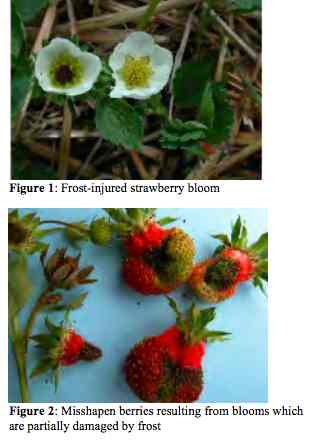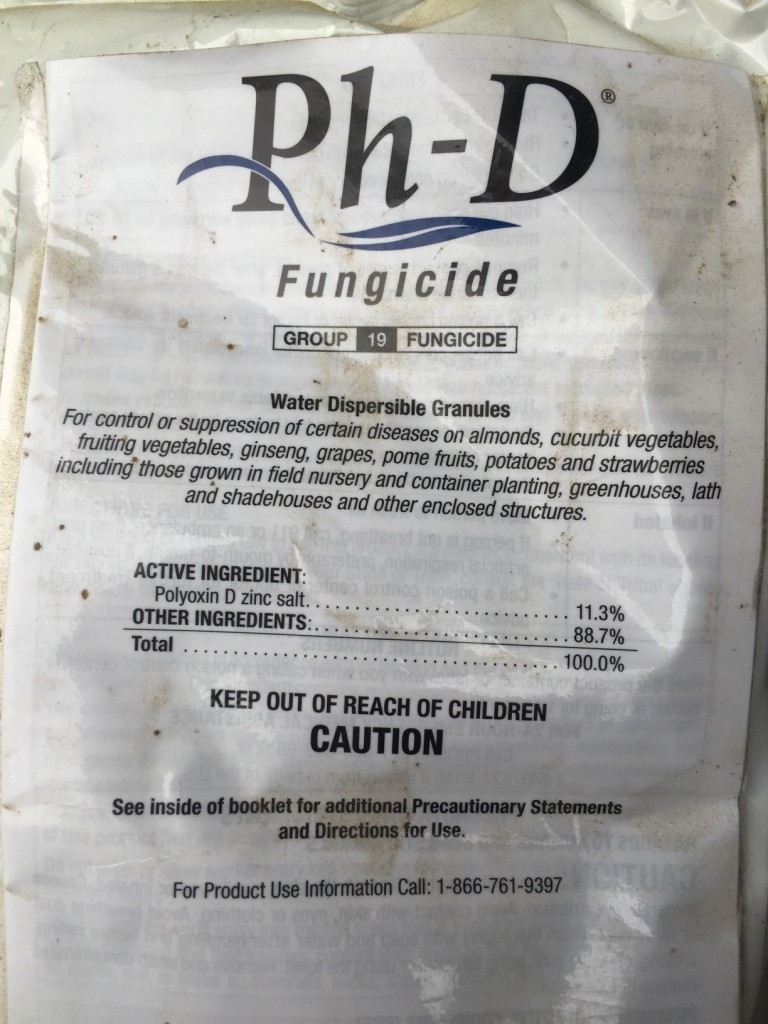Questions From the Field Today About Misshapen Berries and Question About a Fungicide; Events Planned Across NC (Friday, 4/17/15)
go.ncsu.edu/readext?352474
en Español / em Português
El inglés es el idioma de control de esta página. En la medida en que haya algún conflicto entre la traducción al inglés y la traducción, el inglés prevalece.
Al hacer clic en el enlace de traducción se activa un servicio de traducción gratuito para convertir la página al español. Al igual que con cualquier traducción por Internet, la conversión no es sensible al contexto y puede que no traduzca el texto en su significado original. NC State Extension no garantiza la exactitud del texto traducido. Por favor, tenga en cuenta que algunas aplicaciones y/o servicios pueden no funcionar como se espera cuando se traducen.
Português
Inglês é o idioma de controle desta página. Na medida que haja algum conflito entre o texto original em Inglês e a tradução, o Inglês prevalece.
Ao clicar no link de tradução, um serviço gratuito de tradução será ativado para converter a página para o Português. Como em qualquer tradução pela internet, a conversão não é sensivel ao contexto e pode não ocorrer a tradução para o significado orginal. O serviço de Extensão da Carolina do Norte (NC State Extension) não garante a exatidão do texto traduzido. Por favor, observe que algumas funções ou serviços podem não funcionar como esperado após a tradução.
English
English is the controlling language of this page. To the extent there is any conflict between the English text and the translation, English controls.
Clicking on the translation link activates a free translation service to convert the page to Spanish. As with any Internet translation, the conversion is not context-sensitive and may not translate the text to its original meaning. NC State Extension does not guarantee the accuracy of the translated text. Please note that some applications and/or services may not function as expected when translated.
Collapse ▲Que. 1. Can you share a photo of misshapen fruit caused by frost damage to bloom?
Ans. 1. See below – this is from U-MASS Berry Notes, May 2013, Vol. 25, No. 5
http://strawberries.ces.ncsu.edu/wp-content/uploads/2013/05/13MBNMay.pdf
Que. 2. Also, I wish to know relationship between misshapen berries and poor pollination
Ans. 2. This was addressed in a 2013 blog by Dr. Burrack: http://ncsmallfruitsipm.blogspot.com/2012/04/what-causes-misshapen-strawberries.html
She points out that strawberries do not require, but benefit from insect pollination. And, weather conditions that limit insect activity can pollen movement typically precede when this type of misshapen fruit appears:
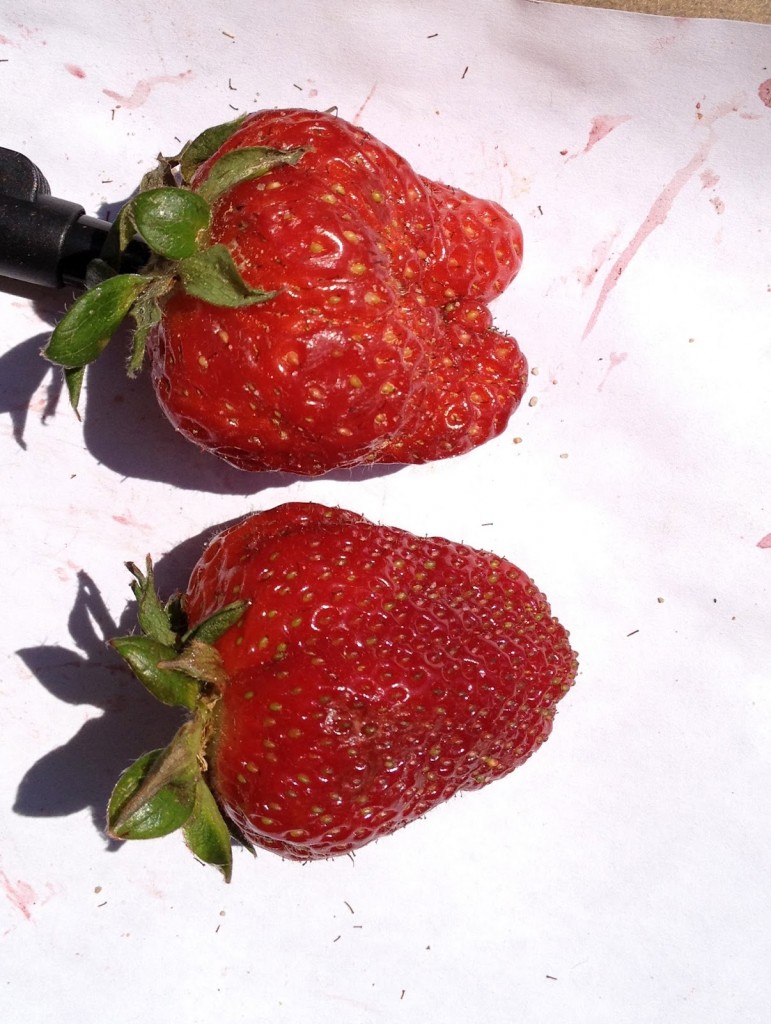 Fig. 2. Dr. Burrack notes in her blog that: Poor pollination causes misshapen fruit because unfertilized seeds remain small and the fruit around them does not grow at the same rate as the fruit around fertilized seeds. On the image above, the top fruit has seeds of different sizes next to each other while the seeds on the bottom fruit are uniform.
Fig. 2. Dr. Burrack notes in her blog that: Poor pollination causes misshapen fruit because unfertilized seeds remain small and the fruit around them does not grow at the same rate as the fruit around fertilized seeds. On the image above, the top fruit has seeds of different sizes next to each other while the seeds on the bottom fruit are uniform.
Editor’s note: I just received this photo of misshapen green fruit – due to pollination. Note the striking differences in in seed sizes. The unfertilized seeds did not grow and are significantly smaller than ones that were fertilized (Fig. 3).
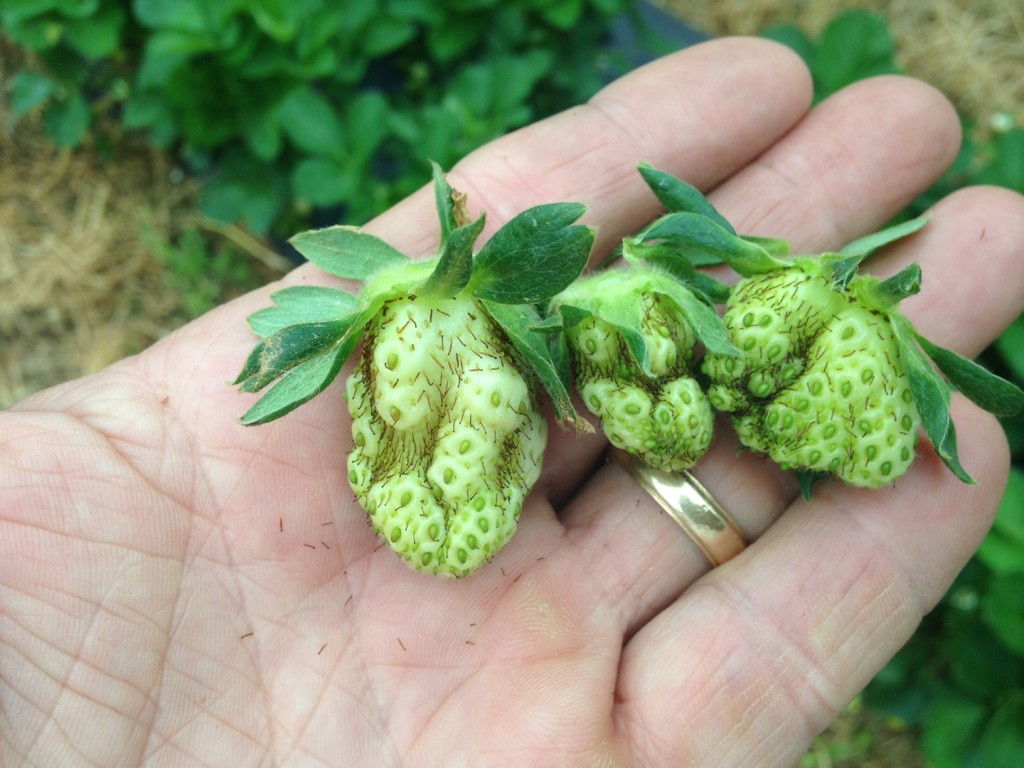 Fig. 3. Photo sent by Eric Hunter, 4/16/15. Note the much larger fertilized seeds (achenes) by comparison to the very small, unfertilized seeds.
Fig. 3. Photo sent by Eric Hunter, 4/16/15. Note the much larger fertilized seeds (achenes) by comparison to the very small, unfertilized seeds.
Mr. Hunter started seeing this yesterday, and noted that is was quite prevalent in his first flush of blooms, but said, “Seeing some distorted fruit in second and third output of blooms. Could that have been some blooms touching the row cover during the last freeze (March 29)? As I responded this morning, I believe this is due to poor pollination. In the berry on left, it is quite clear that the smaller seeds in the “grooves” were not fertilized, and I don’t see the more general blackening of areas of the fruit that are associated with partial frost damage to blossoms (see Fig. 1). At the end of March, row covers were on this particular Camarosa crop (for bloom protection against a serious freeze event 3/28-3/29).
The same grower who sent the photo in Fig. 3, had a question about lygus injury. This is also discussed in Dr. Burrack’s blog: “Lygus feeding does result in variable seed size and can, therefore, be distinguished from poor pollination in strawberries.” (Fig. 4)
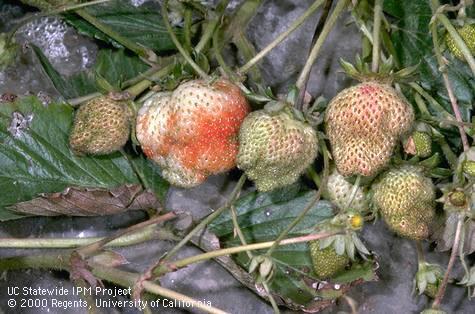 Fig. 4. Lygus feeding results in variable seed size
Fig. 4. Lygus feeding results in variable seed size
Misshapen berries and low boron – David Dycus <ddycus@fciag.com>
Low boron can also cause mis-shapened fruit and is more common than it used to be. It affects green unripe fruit and red ripe fruit too, basically all the fruit will be mis-shaped on the tip ends on a plant. I recommend Boron if tissue samples fall below an index of 55. (Of course, they (NCDA) don’t recommend it unless it goes below 50 on the index) but I have seen and corrected low boron fruit where indexes never got below 50. That’s why I use 55 as a guide, fyi
Question 3. Do you know much about the fungicide Ph D? (from grower in Arkansas)
Ans. 3. I do not, but thanks for sending photo of this label and so far I have had a little feedback (not much).
Dr. Schnabel at Clemson, he said: “We are testing now Ph-D. It looks promising.”
Received this note today from Dexter Hill about NC Crop
Dexter Hill
Marketing Specialist
NCDA&CS
202 Cunningham Road
Kinston NC 28501
Phone (252) 527-7125
Fax (252) 527-2893
Question 4. Kent County, VA – seeing what may be Fe chlorosis?
Dr. Poling,
Good evening! First I’d like to thank you for the strawberry updates throughout the year. I have been in agriculture for years. This is my first year attempting to produce strawberries. Your updates have been hugely helpful, as this has been a learning experience for sure!
When looking over my field of 1st year Chandlers, I noticed that the older leaves on a few plants are starting to yellow. I have attached a picture. Do you have any idea what could be causing this and if it will affect the crop? Also, what can I do to help correct this? The field is in the talleysville area of New Kent County, VA (just outside of Richmond). It has been pretty wet the last few weeks. Any advise would be appreciated.
Thank you again!
Charles Evelyn
Cherry Lane Farm
New Kent VA
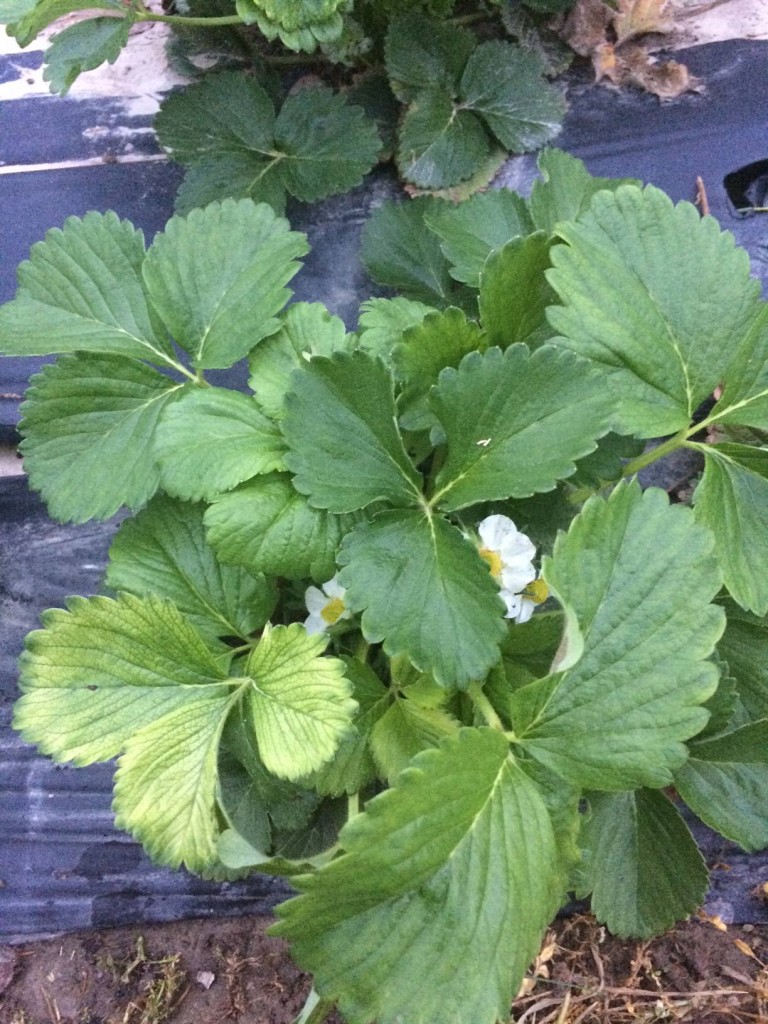 Fig. 5. Va grower seeing Chandler with these symptoms right now.
Fig. 5. Va grower seeing Chandler with these symptoms right now.
Ans. 5. Thanks for your note. I was actually going through the University of California Integrated Pest Management Guide (2nd edition) on another questions related to lygus when I got your message. And, I am sharing this photo from that book on p.106:
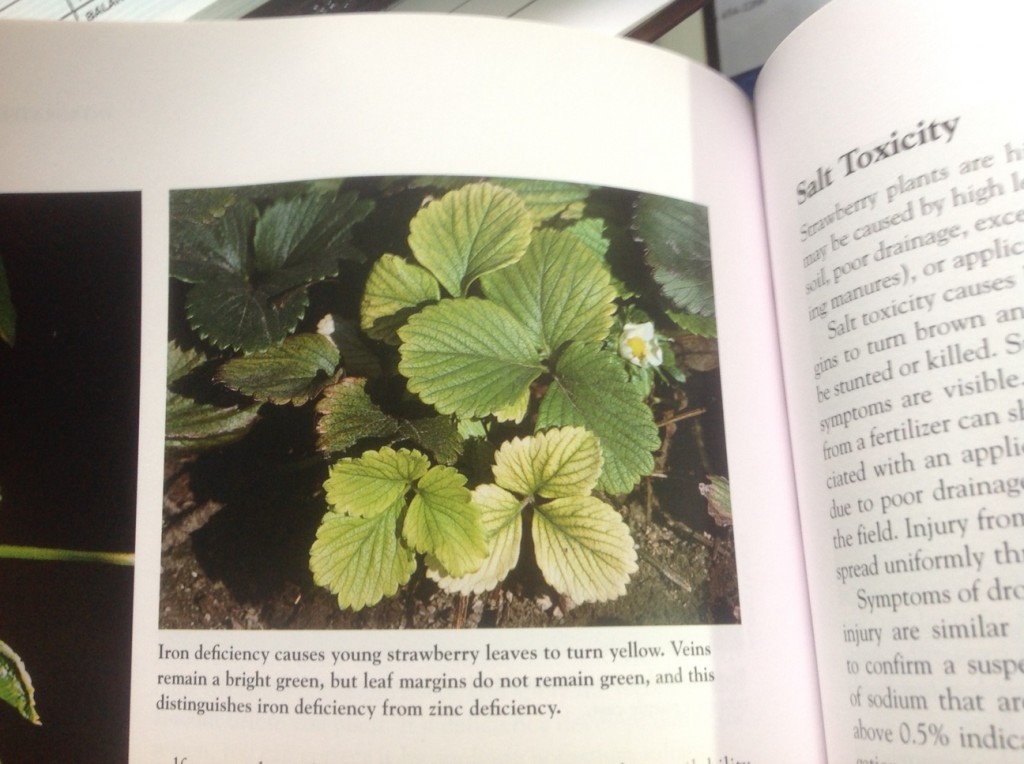 Fig. 6. UC IPM Guide 2nd edition, p. 106. The guide notes that iron deficiency causes young leaves to turn mostly yellow, but with bright green veins.
Fig. 6. UC IPM Guide 2nd edition, p. 106. The guide notes that iron deficiency causes young leaves to turn mostly yellow, but with bright green veins.
(cont’d)
I would suggest getting tissue test made ASAP to confirm whether you might be dealing with Fe defic. For additional information on plant tissue testing, you may go to Agronomic Division of NCDA & CS webiste for instructions on collecting a sample:
 Plant tissue sampling will be key to determining if there is an Fe “issue” http://www.ncagr.gov/agronomi/uyrplant.htm.
Plant tissue sampling will be key to determining if there is an Fe “issue” http://www.ncagr.gov/agronomi/uyrplant.htm.
I also understand that VDACS has a special program this season for free plant tissue samples for VA Strawberry Growers, but you would need to check with a member of VSA like Tom Baker:
Tom & Anne Baker and Amanda McCann
Brookdale Farm
2060 Vaughan Rd, Virginia Beach, VA 23457
2133 Mt. Pleasant Rd., Chesapeake, VA
Phone: 757-721-0558 Fax: 757-721-4988
E-mail: brookdale.farm@cox.net<mailto:brookdale.farm@cox.net>
Also, it would be well to know what your pre-plant soil pH was?
Be sure to be in touch with VA Tech Specialist,
Small Fruit Production Specialist
Hampton Roads AREC, Department of Horticulture
1444 Diamond Springs Rd., Virginia Beach
VA 23455
Good luck!
Raleigh, NC 27695-7609



